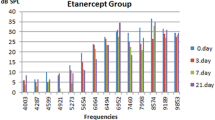Summary
A new method for the quantitative assessment of acute ototoxic side effects of drugs in described. It is suitable for screening purposes. The method is based on the determination of the toxic dose (TD 50) which causes a defined hearing loss in 50% of the animals tested. The hearing loss is defined as a complete suppression of the compound action potential (CAP) of the auditory nerve, elicited by clicks 30 dB above threshold. This is approximately equivalent to a clinical hearing loss of 30 dB. The TD 50 is used to estimate the therapeutic range. With this approach ototoxic side effects of furosemide, piretanide and bumetanide were compared quantitatively in cats. The TD 50 values for CAP suppression were 18.37 mg/kg for furosemide; 4.29 mg/kg for piretanide and 2.21 mg/kg for bumetanide. As equipotent diuretic doses are 2.61 mg/kg for furosemide, 0.26 mg/kg for piretanide and 1.16 mg/kg for bumetanide, it appears that the relative ototoxicity is least for piretanide and highest for bumetanide. Plasma concentrations, determined initially and when recovery of CAP to 50% of control had occured, indicate that bumetanide may be more slowly eliminated from the cochlear spaces than furosemide and piretanide.
In addition azosemide and ozolinone were tested. The TD 50 for azosemide was <10 mg/kg. With ozolinone where there are two isomers, only the diuretic (−)ozolinone was ototoxic; the TD50 was <100 mg/kg.
It is argued that for the assessment of ototoxic side effects of drugs the CAP should be used as an indicator rather than the cochlear microphonic or the endocochlear potentials. It is also important that the CAP be measured in the lower, linear part of its intensity curve.
Similar content being viewed by others
References
Aran JM (1971) The electro-cochleogram. Arch Klin Exp Ohr-Hals-Kehlk. Heilk 198:128–141
Bobbin RP, Kisiel DL (1981) Physiology of hearing. In: Brown RP, Daigneault EA (eds) Pharmacology of hearing. Wiley, New York, pp 19–50
Brown RD (1976) Effect of bumetanide on the positive endochlear de potential of the cat. Toxicol Appl Pharmacol 38:137–144
Brown RD (1981) Comparison of the acute effects of i. v. furosemide and bumetanide on the cochlear action potential (N1), and on the A.C. cochlear potential (CM) at 6 kHz in cats, dogs and guinea pigs. Scand Audiol Suppl 14:71–83
Brown RD, Manno JE, Daigneault EA, Manno BR (1979) Comparative acute ototoxicity of intravenous bumetanide and furosemide in the pure-bred beagle. Toxicol Appl Pharmacol 4:157–169
Evans EF, Klinke R (1974) Reversible effects of cyanide and furosemide on the tuning of single cochlear nerve fibres. J Physiol (Lond) 242:129–130
Evans EF, Klinke R (1982a) The effects of intracochlear cyanide and tetrodotoxin on the properties of single cochlear nerve fibres in the cat. J Physiol (Lond) 331:385–408
Evans EF, Klinke R (1982b) The effects of intracochlear and systemic furosemide on the properties of single cochlear nerve fibres in the cat. J Physiol (Lond) 331:409–427
Galley N, Klinke R, Oertel W, Pause M, Storch W-H (1973) The effect of intracochlearly administered acetylcholine-blocking agents on the efferent synapses of the cochlea. Brain Res 64:55–63
Göttl KH, Klinke R (1977) Differential susceptibility of positive- and negative-going portion of cochlear microphonics to anoxia. In: Portmann M, Aran JM (eds) Inner ear biology, vol 68, INSERM, Paris pp 103–104
Greven J, Defrain W, Glaser K, Meywald K, Heidenreich O (1980) Studies with the optically active isomeres of the new diuretic drug ozolinone. I. Differences in stereoselectivity of the renal target structure of ozolinone. Pflügers Arch 384:57–60
Juhn SK, Rybak CP (1981) Labyrinthine barriers and cochlear homeostasis. Acta Otolaryngol 91:529–534
Juhn SK, Rybak LP, Morizono T, Green LP (1981) Pharmacokinetics of furosemide in relation to the alteration of endocochlear potential. Scand Audiol suppl 14:39–49
Kiang NYS, Liberman MC, Levine RA (1976) Auditory-nerve activity in cats exposed to ototoxic drugs and high-intensity sounds. Ann Otol Rhinol Laryngol 85:752–769
Klinke R, Göttl KH, Roesch A (1981) Testing strategy for ototoxic side effects. Scand Audiol suppl 14:95–109
Liberman MC, Kiang NYS (1978) Acoustic trauma in cats. Acta Oto-Laryngol suppl 358:5–62
Peake WT, Kiang NYS (1962) Cochlear responses to condensation and rarefaction clicks. Biophys J 2:23–34
Prazma J (1981) Ototoxicity of diuretics. In: Brown RD, Daigneault EA (eds) Pharmacology of hearing. Wiley, New York, pp 197–229
Robertson D, Manley GA (1974) Manipulation of frequency analysis in the cochlear ganglion of the guinea pig. J Comp Physiol 91:363–375
Rybak LP (1983) Comparative study of the ototoxicity of furosemide and piretanide. Ass Res Otolaryngol 6th Midwinter Res Meeting, p 53
Sachs L (1974) Angewandte Statistik. Springer, Berlin Heidelberg New York
Sewell WF (1984) The relation between the endocochlear potential and spontaneous activity in auditory nerve fibres of the cat. J Physiol (Lond) 347:685–696
Author information
Authors and Affiliations
Rights and permissions
About this article
Cite this article
Göttl, K.H., Roesch, A. & Klinke, R. Quantitative evaluation of ototoxic side effects of furosemide, piretanide, bumetanide, azosemide and ozolinone in the cat — a new approach to the problem of ototoxicity. Naunyn-Schmiedeberg's Arch. Pharmacol. 331, 275–282 (1985). https://doi.org/10.1007/BF00634249
Received:
Accepted:
Issue Date:
DOI: https://doi.org/10.1007/BF00634249




